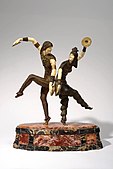Demétre Chiparus
Demétre Chiparus | |
|---|---|
Dumitru Haralamb Chipăruș | |
| Born | 16 September 1886 Bagneux Cemetery |
| Education | École des Beaux-Arts |
| Known for | Sculptures |
| Movement | Art Deco in Paris |
Demétre Haralamb Chiparus (Romanian: Dumitru Haralamb Chipăruș; 16 September 1886 – 22 January 1947) was a Romanian sculptor of the Art Deco-era who lived and worked in Paris, France. He was one of the most important sculptors of the time.
Life
Demétre Chiparus, born as Dumitru Haralamb Chipăruș
Work
Early career
The first sculptures of Chiparus were created in the realistic style and were exhibited at the
Later career
The mature style of Chiparus took shape beginning in the 1920s. His sculptures are remarkable for their bright and outstanding decorative effect. Dancers of the
Chiparus created one of the most iconic bronzes in 1928 called "Danseuse au cerceau" or "Ring Dancer" inspired in the famous and prodigious dancer Zoula de Boncza of the Parisian "Folies Bergère", a first dancer of The Belgrado Royal Opera and a Mime dancer of "l'Opéra-Comique" in Paris. Later in life de Boncza, a descendant of Polish nobility and one of Loie Fuller best students, created a book published in 1961: the dance method "La Danse classique sans barre". The book was published with texts from Eugène de Rijac and illustrations by Alexandre Berlant and Yvonne Breton.
He worked primarily with the Edmond Etling and Cie Foundry in Paris owned by
The Salon
Chiparus rarely exhibited at the
For a time in the early 1940s almost no works of Chiparus were sold but he continued sculpting for his own pleasure, depicting animals in the Art Deco style. At the 1942 Paris Salon, the plaster sculptures “Polar Bear” and “American Bison” were exhibited and in 1943 he showed a marble “Polar Bear” and plaster “Pelican”.
Style
Sculptures of Chiparus represent the classical manifestation of Art Deco style in decorative bronze ivory sculpture. Traditionally, four factors of influence over the creative activity of the artist can be distinguished:
After the
Collector interest in the work of Chiparus appeared in the 1970s and has flourished since the 1990s. A major collection of Chiparus' work is on display in the permanent collection of
.Death and legacy
Demétre Chiparus died in
Gallery
-
Tânără (Girl)
-
Dansatoare Egipteană (Egyptian Dancer)
-
Fetele (The Girls)
-
Dansatori Ruși (Russian Dancers)
References
- ^ "Dumitru Chipăruș – un maestru remarcabil al detaliilor în bronz" (in Romanian). 4 October 2015.
- ^ ISBN 978-1-85149-382-1.
Sources
- Alberto Shayo Chiparus - Master of Art Deco (Abbeville Press, Publishers 1993) ISBN 1-55859-475-2
- Victor Arwas. «Art deco» — London: 1992 [1]
- Victor Arwas. «Art Deco Sculpture: Chryselephantine Statuettes of the Twenties and Thirties» — London: 1975 [2]
- Bryan Catley. «Art Deco and other Figures» — Woodbridge, Suffolk: 1978 [3]
- Alexey Witt. «Demetre Chiparus - the great sculptor of an era of the Art deco» - A. Witt & D. Leontyev, Moscow: 2015 [4]
External links
- Gallery of sculptures Archived 2011-09-19 at the Wayback Machine
- Examples of his works
- Demétre Chiparus in American public collections, on the French Sculpture Census website




